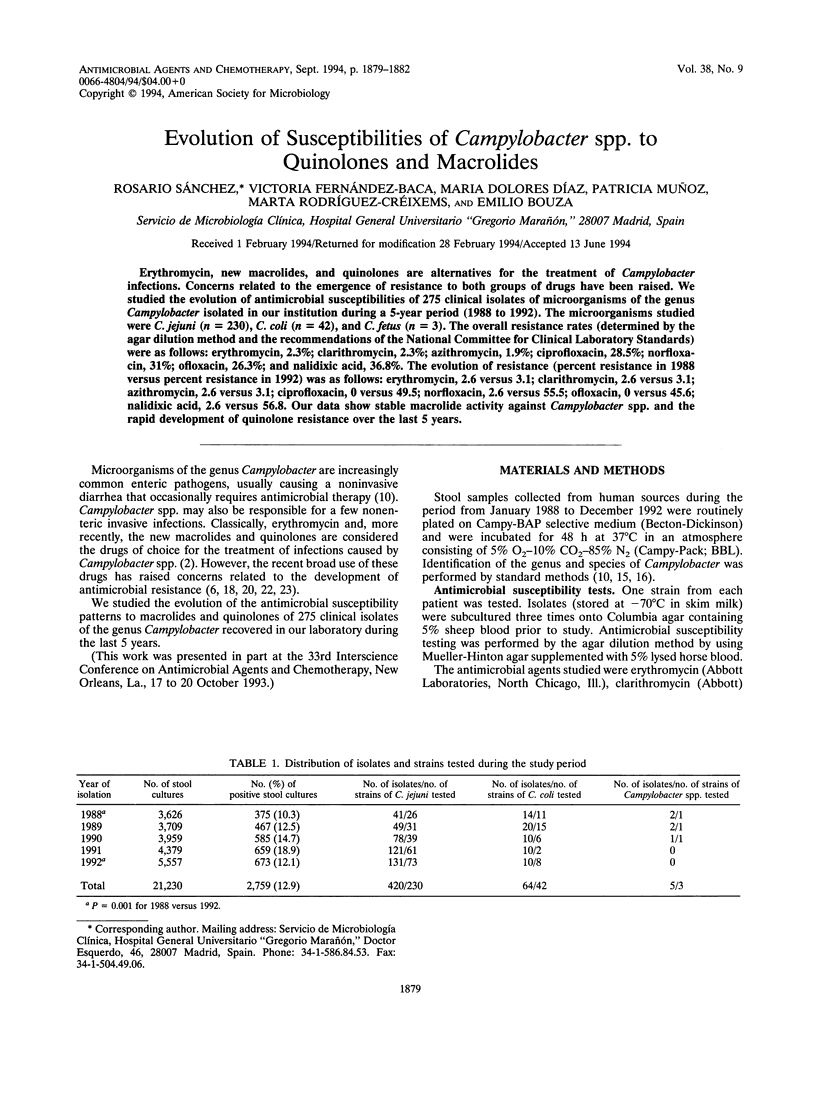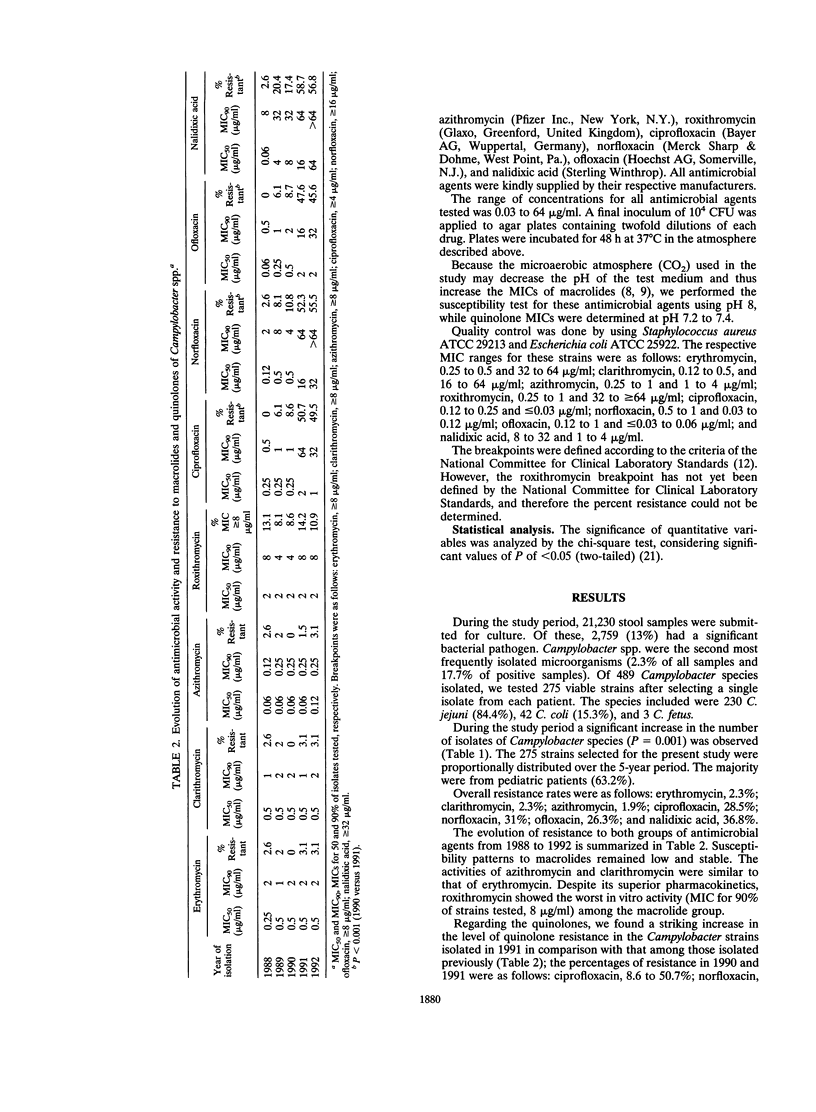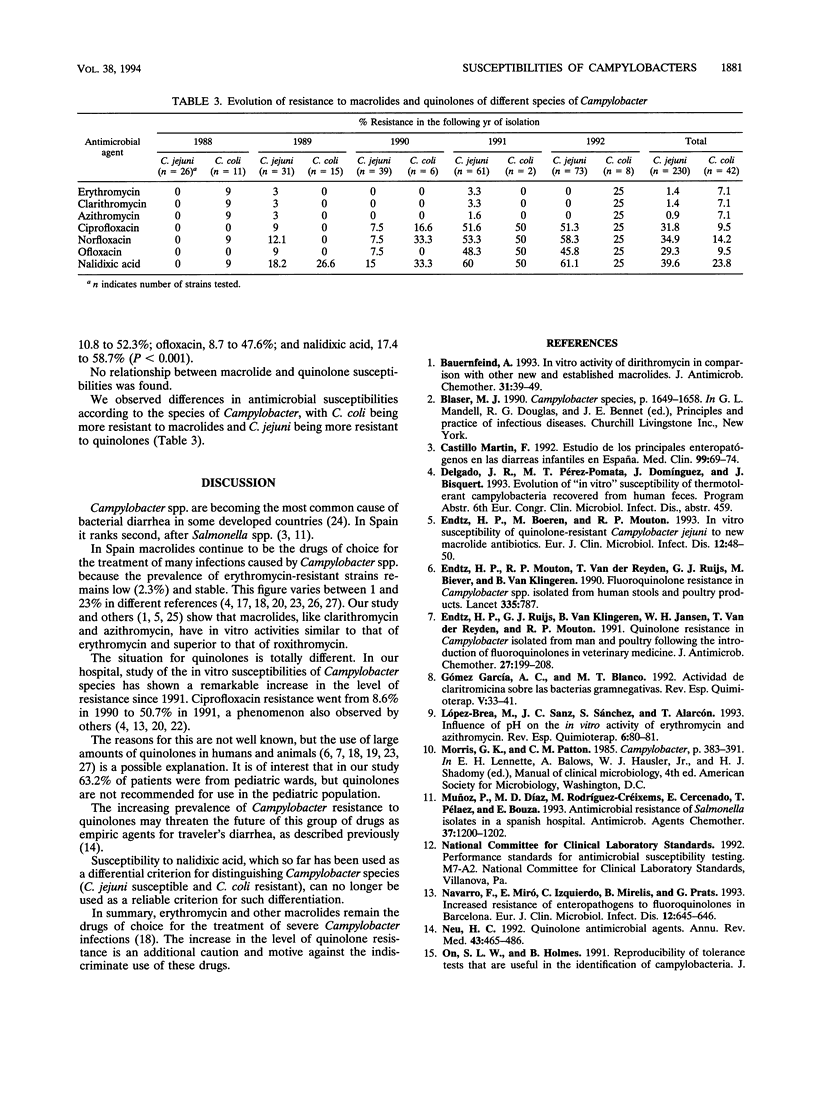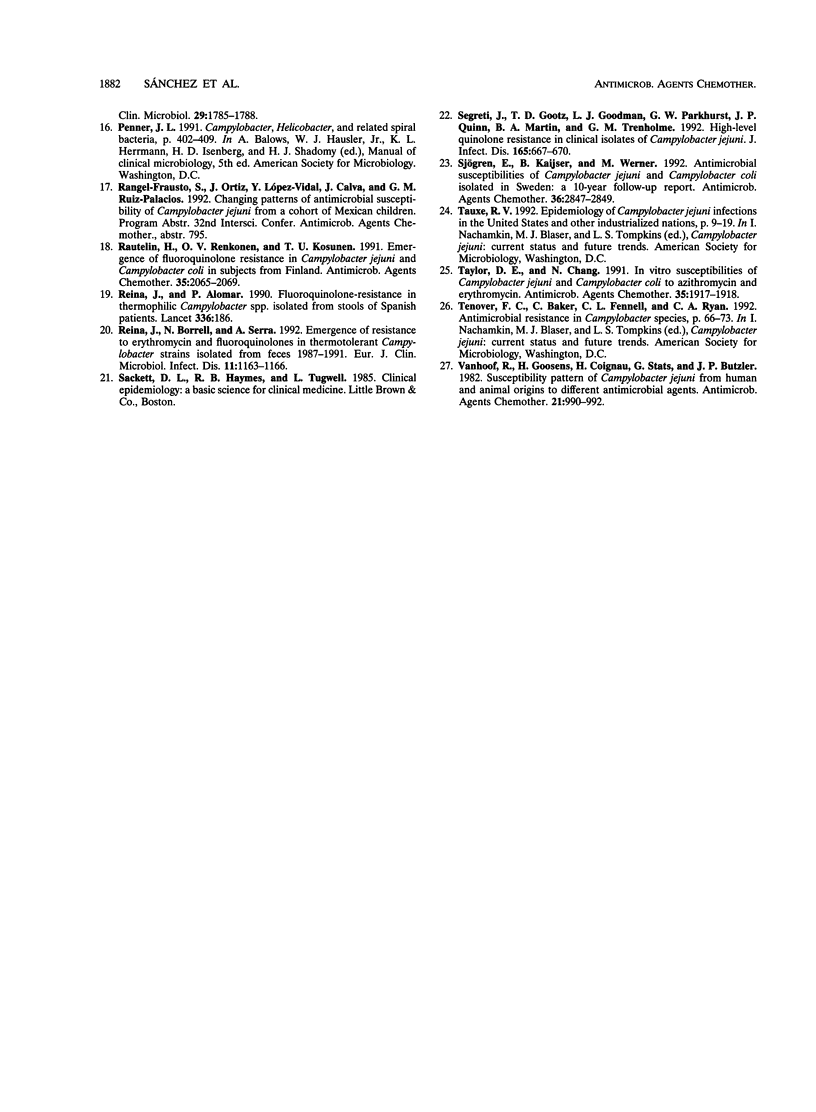Abstract
Erythromycin, new macrolides, and quinolones are alternatives for the treatment of Campylobacter infections. Concerns related to the emergence of resistance to both groups of drugs have been raised. We studied the evolution of antimicrobial susceptibilities of 275 clinical isolates of microorganisms of the genus Campylobacter isolated in our institution during a 5-year period (1988 to 1992). The microorganisms studied were C. jejuni (n = 230), C. coli (n = 42), and C. fetus (n = 3). The overall resistance rates (determined by the agar dilution method and the recommendations of the National Committee for Clinical Laboratory Standards) were as follows: erythromycin, 2.3%; clarithromycin, 2.3%; azithromycin, 1.9%; ciprofloxacin, 28.5%; norfloxacin, 31%; ofloxacin, 26.3%; and nalidixic acid, 36.8%. The evolution of resistance (percent resistance in 1988 versus percent resistance in 1992) was as follows: erythromycin, 2.6 versus 3.1; clarithromycin, 2.6 versus 3.1; azithromycin, 2.6 versus 3.1; ciprofloxacin, 0 versus 49.5; norfloxacin, 2.6 versus 55.5; ofloxacin, 0 versus 45.6; nalidixic acid, 2.6 versus 56.8. Our data show stable macrolide activity against Campylobacter spp. and the rapid development of quinolone resistance over the last 5 years.
Full text
PDF



Selected References
These references are in PubMed. This may not be the complete list of references from this article.
- Bauernfeind A. In-vitro activity of dirithromycin in comparison with other new and established macrolides. J Antimicrob Chemother. 1993 Mar;31 (Suppl 100):39–49. doi: 10.1093/jac/31.suppl_c.39. [DOI] [PubMed] [Google Scholar]
- Endtz H. P., Broeren M., Mouton R. P. In vitro susceptibility of quinolone-resistant Campylobacter jejuni to new macrolide antibiotics. Eur J Clin Microbiol Infect Dis. 1993 Jan;12(1):48–50. doi: 10.1007/BF01997058. [DOI] [PubMed] [Google Scholar]
- Endtz H. P., Mouton R. P., van der Reyden T., Ruijs G. J., Biever M., van Klingeren B. Fluoroquinolone resistance in Campylobacter spp isolated from human stools and poultry products. Lancet. 1990 Mar 31;335(8692):787–787. doi: 10.1016/0140-6736(90)90897-e. [DOI] [PubMed] [Google Scholar]
- Endtz H. P., Ruijs G. J., van Klingeren B., Jansen W. H., van der Reyden T., Mouton R. P. Quinolone resistance in campylobacter isolated from man and poultry following the introduction of fluoroquinolones in veterinary medicine. J Antimicrob Chemother. 1991 Feb;27(2):199–208. doi: 10.1093/jac/27.2.199. [DOI] [PubMed] [Google Scholar]
- Muńoz P., Díaz M. D., Rodríguez-Créixems M., Cercenado E., Peláez T., Bouza E. Antimicrobial resistance of Salmonella isolates in a Spanish hospital. Antimicrob Agents Chemother. 1993 May;37(5):1200–1202. doi: 10.1128/aac.37.5.1200. [DOI] [PMC free article] [PubMed] [Google Scholar]
- Navarro F., Miró E., Izquierdo C., Mirelis B., Prats G. Increased resistance of enteropathogens to fluoroquinolones in Barcelona, Spain. Eur J Clin Microbiol Infect Dis. 1993 Aug;12(8):645–646. doi: 10.1007/BF01973651. [DOI] [PubMed] [Google Scholar]
- Neu H. C. Quinolone antimicrobial agents. Annu Rev Med. 1992;43:465–486. doi: 10.1146/annurev.me.43.020192.002341. [DOI] [PubMed] [Google Scholar]
- Rautelin H., Renkonen O. V., Kosunen T. U. Emergence of fluoroquinolone resistance in Campylobacter jejuni and Campylobacter coli in subjects from Finland. Antimicrob Agents Chemother. 1991 Oct;35(10):2065–2069. doi: 10.1128/aac.35.10.2065. [DOI] [PMC free article] [PubMed] [Google Scholar]
- Reina J., Alomar P. Fluoroquinolone-resistance in thermophilic Campylobacter spp isolated from stools of Spanish patients. Lancet. 1990 Jul 21;336(8708):186–186. doi: 10.1016/0140-6736(90)91715-m. [DOI] [PubMed] [Google Scholar]
- Reina J., Borrell N., Serra A. Emergence of resistance to erythromycin and fluoroquinolones in thermotolerant Campylobacter strains isolated from feces 1987-1991. Eur J Clin Microbiol Infect Dis. 1992 Dec;11(12):1163–1166. doi: 10.1007/BF01961137. [DOI] [PubMed] [Google Scholar]
- Segreti J., Gootz T. D., Goodman L. J., Parkhurst G. W., Quinn J. P., Martin B. A., Trenholme G. M. High-level quinolone resistance in clinical isolates of Campylobacter jejuni. J Infect Dis. 1992 Apr;165(4):667–670. doi: 10.1093/infdis/165.4.667. [DOI] [PubMed] [Google Scholar]
- Sjögren E., Kaijser B., Werner M. Antimicrobial susceptibilities of Campylobacter jejuni and Campylobacter coli isolated in Sweden: a 10-year follow-up report. Antimicrob Agents Chemother. 1992 Dec;36(12):2847–2849. doi: 10.1128/aac.36.12.2847. [DOI] [PMC free article] [PubMed] [Google Scholar]
- Taylor D. E., Chang N. In vitro susceptibilities of Campylobacter jejuni and Campylobacter coli to azithromycin and erythromycin. Antimicrob Agents Chemother. 1991 Sep;35(9):1917–1918. doi: 10.1128/aac.35.9.1917. [DOI] [PMC free article] [PubMed] [Google Scholar]
- Vanhoof R., Goossens H., Coignau H., Stas G., Butzler J. P. Susceptibility pattern of Campylobacter jejuni from human and animal origins to different antimicrobial agents. Antimicrob Agents Chemother. 1982 Jun;21(6):990–992. doi: 10.1128/aac.21.6.990. [DOI] [PMC free article] [PubMed] [Google Scholar]
- del Castillo Martín F. Estudio de los principales enteropatógenos en las diarreas infantiles en España. Med Clin (Barc) 1992 Jun 6;99(2):69–74. [PubMed] [Google Scholar]


